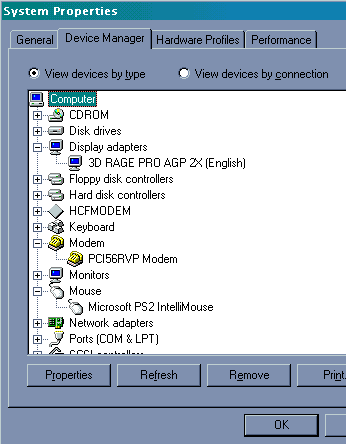
 Devices Devices
A PC is constructed from a number of smaller components. Each of these
components performs some specific function and are called 'Devices'
e.g
A Printer is a device and whose function is to print. (simple eh?)
All Devices are connected to your PC's Motherboard or System
Board, which is inside your PC's Case.

Devices can next be classed into Internal and External
External Devices are those that reside outside the PC's Case and
are connected to the Motherboard via a socket on the outside of the PC
case.
e.g A Printer device is connected via a printer lead to a socket on the
back of your PC. Other external devices include your Keyboard, Mouse and
Monitor
Internal Devices are all the devices (including the Motherboard)
inside your PC's case. Internal Devices are connected to the Motherboard
in 2 ways
1. 'On Board' are a class of devices that are permanently attached
to your Motherboard and which cannot be removed.
2 Cards/ Expansion Cards are a class of devices that can be removed
and inserted (or 'Seated') onto the Motherbaord.
e.g. A Graphics Card is attached to your PC's Motherboard inside
the PC Case. This produces the image on your Monitor. This Device is either
in the form of a seperate removable Card or is 'On Board'.
 Advantages and Disadvantages
of Internal and External Devices Advantages and Disadvantages
of Internal and External Devices
External Devices
- External Devices are generally easier to install , since you don't
need to open your PC's Case. You just need to plug 'em in.
- Most External Devices (put not all) need a seperate power supply.
Internal Devices
- Internal Devcies are a little more difficuilt to install because you
need to open the PC case to connect them. A screwdriver would be usefull...
- Internal Devices don't need an extra power supply, since they get
their power from your PC's main supply.
- Internal Devices are generally cheaper since they don't need a seperate
power supply and also don't need a case of their own.
 Device Drivers Device Drivers
Generally for every Device attached to your motherbaord you'll need installed
a piece of software that tells your PC:-
- The type of Device (e.g printer, mouse, modem, graphics card)
- Manufacturer
- The Model
- How your PC communicates with it.
Note: The Device Manufacturer is probably NOT the manufacturer that
supplied your PC. The manufacturer who supplied your PC simply put it
togther for you.
When you purchased your PC all the Drivers should be pre-installed. You
should also get a copy of these drivers supplied with your PC either on
CD or Floppy Discs just incase you need to re-install them. The major
PC manufacturers will put all the drivers on one CD which will be marked
'Drivers Disc' or 'Support Disc'.
If you purchase a new Device you should get a copy of the drivers and
instructions on how to install them.
How do I know which Drivers to use?
When you purchased your PC all the Drivers should be pre-installed. You
should also get a copy of these drivers supplied with your PC either on
CD or Floppy Discs just incase you need to re-install them. The major
PC manufacturers will put all the drivers on one CD which will be marked
'Drivers Disc' or 'Support Disc'. If you purchase a new Device you should
also get a copy of the drivers and instructions on how to install them.
If you don't have the Manual or Drivers Disc's or all the drivers are
on one CD and you're unsure which ones to use then the simple answer to
this is that you need to know 3 things about your Device
For External Devices this is simple since they will have all this information
on the case or you can check the manual supplied.
e.g. Epson printers have this clearly market.
- Type : PRINTER
- Manufacturer: EPSON
- Model: STYLUS COLOR 440 (note: american spelling)
For Internal Devices this can a be a little bit more tricky for these
reasons
- You'll need to know weather it's a seperate 'Expansion Card' or 'Onboard
Device'
- If you don't have a copy of the devices drivers or manual for some
reason and the device is a seperate 'Expansion Card' you'll have to
open the back of your PC and look for this infomation printed on the
card itself. And know which card you should be looking at!
- If it's an 'On Board' device. Even if you open the PC you probably
won't find any infomation on the device. In this case you'll need to
find out the Manufacturer and Model of the Motherboard.
 Back
to Help Desk Back
to Help Desk
|
![]()